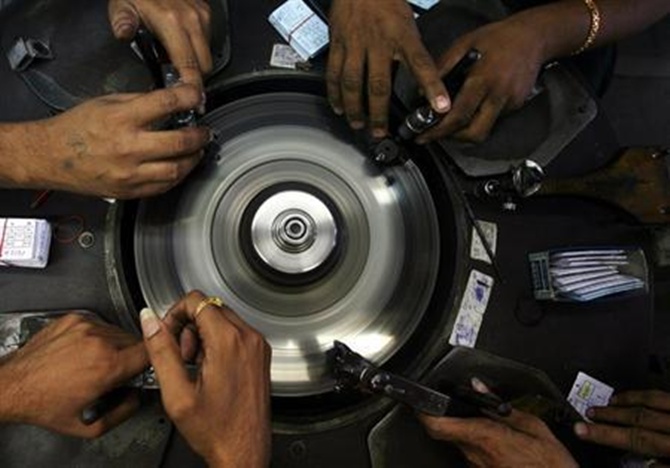 | « Back to article | Print this article |
Sources say of the 4,000 units in Surat, about half have been shut.

With the diamond sector in Surat recording hundreds of crores of losses and payment defaults on the rise, a cloud of uncertainty looms over workers in India’s diamond capital.
Sources estimate 70-80 per cent of them have been affected by retrenchment, pay cuts or reduced working hours.
To tackle the crisis, diamond exporters are considering stopping the import of rough diamonds into the country, at least for a month or two.
Dinesh Navadia, president of the Surat Diamond Association, said, “A meeting on the matter has been held in Mumbai.
“But as of now, Surat-based traders have not decided anything on those lines.”
 Image: A diamond businessmen demonstrates a process at a diamond cutting and polishing factory in Surat. Photograph: Arko Datta/Reuters
Image: A diamond businessmen demonstrates a process at a diamond cutting and polishing factory in Surat. Photograph: Arko Datta/Reuters
Sources said a vote on the matter would be held in Surat.
“While I am not aware of any formal decision being taken, it is a natural step to ensure production control at a time when the inventory is huge and sales aren’t moving.
“Globally, diamond demand has taken a hit, impacting both rough and polished diamonds,” said Mathur Savani of Surat-based Savani Brothers.
Prices of rough diamonds have fallen eight to nine per cent since last year, eroding the margins of several companies.
Prices of polished diamonds, too, had fallen 20-22 per cent, sources said. As such, retail demand for diamonds has shrunk, traders say.

Surat imports about Rs 2 lakh crore (Rs 2 trillion) worth of rough diamonds a year.
If import are stopped for a month or two, it could improve the liquidity situation in the market and raise retail prices.
In the past year and a half, defaults in the Rs 90,000-crore (Rs 900-billion) diamond sector in Surat have run into Rs 1,500 crore (Rs 15 billion), Navadia says.
However, the sector pegs the defaults at about Rs 2,000 crore (Rs 20 billion).
According to market estimates, defaults worth Rs 600-700 crore (Rs 6-7 billion) have been recorded in the past month alone and a turnover of at least Rs 4,000 crore (Rs 40 billion) has been impacted.
However, banks’ exposure to such defaults is learnt to be marginal.
“While both nationalised and private sector banks are exposed to the sector, most defaults have been borne by traders and importers, among others within the industry,” said a trader.
Sources say various factors have led to the crisis.

The penetration of chemical vapour deposition diamonds (treated with special heat and induced with chemicals to make these look like real diamonds) has increased. Also, diamond traders are learnt to have invested in real estate, which has seen prices crash of late.
This has led to a liquidity crisis for traders, resulting in defaults.
Sources say of the 4,000 units in Surat, about half have been shut.
“There are roughly 600,000 workers in the sector, of whom 70-80 per cent have been affected in one way or the other, through direct retrenchment, pay cuts, partial shutdown of units or reduction in work hours.
“For instance, instead of 8 pm earlier, work shifts now end by 5 pm,” said the trader.
Navadia, however, says there haven’t been any significant lay-offs in the sector, adding 80-85 per cent of the default amounts are likely to be recovered.
“There is no dearth of capital in the market as of now and we are in talks with traders, workers and other stakeholders so as to not create a situation of panic,” he said.
About a week ago, a Katargam-based trading company defaulted on payments worth Rs 300 crore (Rs 3 billion) to rough diamond dealers in Mumbai, Surat and Antwerp (Belgium). About 90 rough diamond dealers lost their money.

Many fear they might have to deal with more losses in the next few months.
Laljibhai Patel, chairman of Dharmanandan Diamonds, said, “One would have to bear losses for the next two-three months due to frequent defaults in the market, as well as the prices.
“We are not laying off workers; we didn’t do so during the 2008 crisis, too. When the tables turn, my workers will be the source of my firm’s profits.”
His firm employs about 6,000 workers.
Patel says 2,000-3,000 workers in the sector might be directly affected by the crisis but adds most would find jobs elsewhere.
Struggling with regular defaults and frauds, the diamond sectors in Surat and Mumbai have already started shifting from a ‘chitthi’ (chit) system to ‘jhangad’ (formalised agreements between trading parties).
Unlike the previous system, the new one is considered foolproof, as it involves exchange of entrustment notes. Navadia says through the next year, most Surat-based units will shift to the new system.
| SHINING NO MORE |
|